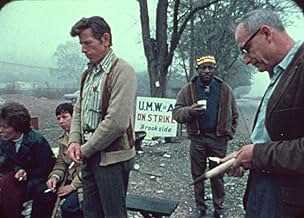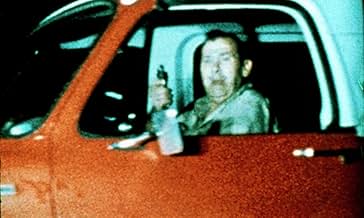Harlan County U.S.A.
- 1976
- Tous publics
- 1h 43m
A heartbreaking record of the thirteen-month struggle between a community fighting to survive and a corporation dedicated to the bottom line.A heartbreaking record of the thirteen-month struggle between a community fighting to survive and a corporation dedicated to the bottom line.A heartbreaking record of the thirteen-month struggle between a community fighting to survive and a corporation dedicated to the bottom line.
- Won 1 Oscar
- 9 wins & 1 nomination total
- Self - Pres., UMW, 1920-1960
- (archive footage)
- Self - Black Ling Clinic., W. Va
- (as Dr. Donald Rasmussen)
- Self
- (as Dr. Hawley Wells Jr.)
- Self - Pres., UMW, 1962-1972
- (archive footage)
- Self
- (archive footage)
- (as Joseph "Jock" Yablonski)
- Self - Mine Foreman
- (as Basil Collins)
Featured reviews
Sure the documentary's one-sided since it shows the vibrant Appalachin coal-mining community struggling in the face of the coal company, strike-breakers, and law-enforcement allies. After all, I guess competing footage would have to be from a company executive session where profits and power are discussed, not indoor plumbing and a living wage. Clearly, the topic sorts itself for the average viewer.
Then there're the faces. You don't get life in the raw like this from a casting call on Hollywood and Vine. The men and women are indelible and a permanent record of the nation's real fabric. True, I don't have much ear for the down-home music that's such a strong narrative part, but I do have a new appreciation for what the artistry stands for. Thanks Barbara Koppel for going where movie-makers seldom go, and recording what many of us seldom see. Sure, that's been 40-years ago, but I dare say the lessons are as topical now as they were then. Maybe more so.
This documentary was filmed over a period of 4 years which in turn showed the lack of speed for a change from a peon work ethic to one of equality. The men of the mine saw the results that a union in other parts of the country and the standard of living that most Americans enjoyed as compared to their own situation. The community of Harlan County had a desire for change from an almost forced labor to one where the worker could make choices, have health care and to not live from pay check to pay check. The men and the woman were willing to risk everything for a better future for their children. The wives of the minors not only lived in the same conditions but had the same drive for changes and a difference. The women not only increased the numbers for picket lines but they also brought the importance of the strike to an `at home' feel. The rough terrain, harsh living community, and dirty, dingy way of life that a miner and a miner's family lived in was adequately represented in the film via the raw nature of the interviews and the in the field live spontaneous coverage. You as the viewer did not sit back and watch the film but instead were brought in to the lives of these men and woman. The filming brought a sense to the audience that you were there on the picket line, you felt the terror of being attacked, and you experienced the chaos when shots were fired at unarmed citizens. The falling of the camera and the blackness of the shot exemplifies the nature of not understanding what was going on at that moment. This in your face type of filming also show all aspects of what a strike of this nature entails. The viewer saw the aftermath and hospitalization of the battles between unarmed men and the `gun -thugs' sent to end picket lines. Like Bordwall and Thompson state the film crew used was small and more mobile, this not only rejected the traditional ideals of script and structure but also allowed the film makers to almost disappear into the back ground and let the action unfold in font of their eyes. This form of filming were there is a no holds bar or in your face tactic shows all portions of the incident, meaning that there is a feeling that the camera was never turned off. It brought light to a subject that most would not have known about, a subject that it profoundly influenced. The press that such documentaries bring to these hidden incidents carries a strong level of change and importance that otherwise would not be there. The filming of these events is intense. The film must express the telling of a complete story, one that ties the events that previously unfolded through the elapsed filming time to a coherent ending, being it either good or bad. The documentary film is a modern day form of passing on a lesson or an experience to a new audience, the modern day word of mouth story telling.
It sometimes loses momentum as it documents the details of a particular labor strike in a mining town in rural Kentucky; yet that particular strike yields many memorable moments, including flashes of violence and revelatory dialogue. The company men are deliciously slick and slimy, and their goons are so ornery, that it's easy to forget that these people are real!
Where this film is at its best is where it uses historical footage and traditional labor songs to tie the strike to the larger past, and also where it explores other details of these people's lives -health issues, living conditions- that aren't specific to the strike. In this sense, the film becomes an important historical document of its own accord; unique, compelling, and enlightening to future generations.
I guess it just goes to show how struggles with the cost of living aren't anything new, and this documentary does a great job of dispelling the idea that everyday people are greedy and want excessive amounts of money. I think most people are underpaid, and people just want the kind of compensation that will lower the stress of life. Bosses and people in charge always seem to hoard money. If this is the way things have to be run, then people who do hard work (and a lot of it) should be appropriately compensated. It's just a shame that some people view protests like this as radical or excessive, and I think a documentary like Harlan County USA could help change minds and attitudes.
Look, it's overall a very good documentary. The simple, natural style works. It's persuasive. Unions are good. I can't fault this stuff.
But this genuinely has one of the worst soundtracks I've ever heard, so uh, I'm sorry... points off for that (the god-awful music just never stops either).
Did you know
- TriviaWhen filming began, the film was intended to be about the 1972 campaign by Arnold Miller and Miners For Democracy to unseat UMWA president Tony Boyle, in the aftermath of Joseph Yablonski's murder; however, the Harlan County strike began and caused the filmmakers to change their principal subject, with the campaign and murder becoming secondary subjects.
- Quotes
Hawley Wells Jr.: [...] that was when I learned my first real political lesson, about what happens when you take a position against the coal operators, against the capitalists... I found out that the union officials were working with the coal companies. I also found that the Catholic hierarchy was working with the coal companies. Here was a combination of the whole thing, you see: you had to bump against the whole combination of them.
- ConnectionsFeatured in Cinéma Vérité: Defining the Moment (1999)
- How long is Harlan County U.S.A.?Powered by Alexa
Details
- Release date
- Country of origin
- Official site
- Language
- Also known as
- Harlan County, USA
- Filming locations
- Production company
- See more company credits at IMDbPro
Contribute to this page























